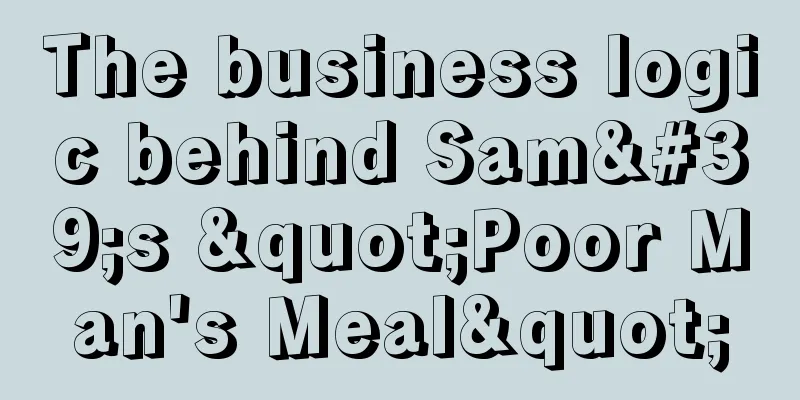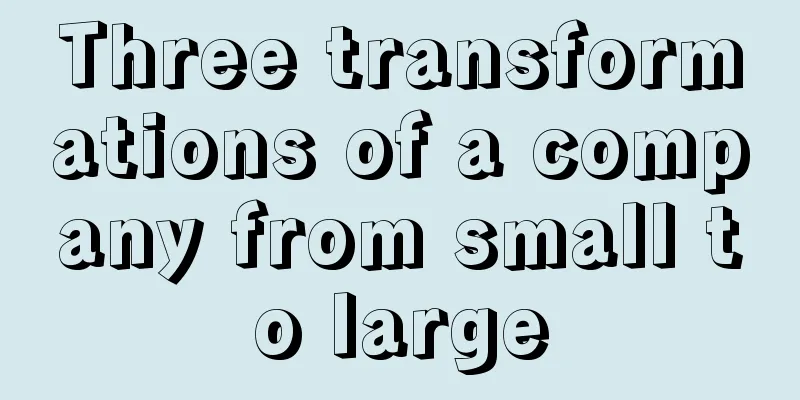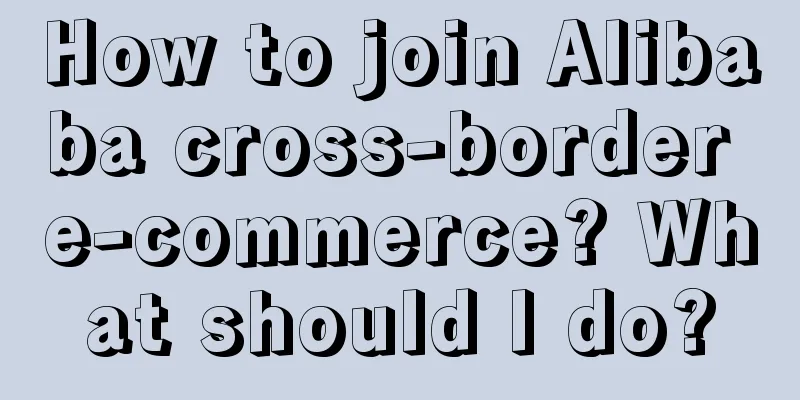The business logic behind Sam's "Poor Man's Meal"

In recent years, popular words in the consumer market have emerged one after another, such as "reverse consumption", "bargain consumption", "consumption upgrade", "refined poverty", "consumption downgrade", "smart saving", "rational saving"... They not only reflect the changes in current market consumption trends, but also show that the consumption psychology and consumption tendencies of contemporary young people are diversified. 1. Sam’s “Poor Man’s Meal” is not intended to be sold to the poorBut are consumers really seeking to save money for the sake of saving money? Can the popular rational saving really save money? Recently, #Young people have gone from being exquisitely poor to being smart and frugal# has once again become a hot topic, sparking widespread discussion among the public. Some people believe that the main reason for "rational saving" is poverty, and being forced to downgrade consumption is not the real intention of young people. Some people say that "saving money" does not mean being unworthy, but is a wise expression of contemporary young people's rejection of the "consumption trap" of merchants, which changes their consumption direction to "save where you should save and spend where you should spend." At the same time, the change from "refined poverty" to "rational saving" also shows that contemporary young people have seen the disadvantages of blind consumption, have a sense of risk, and want to use the money they save in more valuable places. Of course, some people think that this is the reverse consumption behavior of young people, who want to turn the "saving, saving, saving" consumption method into a social means to bring themselves the emotional value of small happiness. In the popular form, being poor is not the reason for young people to choose "rational saving", but there are deeper needs such as social currency and emotional value provision. The change in young people's consumption behavior has also prompted a change in the marketing direction of brands. They have launched activities such as "poor ghost packages", and a variety of promotional methods have also filled the consumption schedule of young people, from breakfast to dinner, from Monday to weekend, so that young people can choose products that they are satisfied with every time they want to "save money". However, not all activities can really help consumers save money. For example, the "poor ghost package" launched by Sam's Club a few days ago has become a hot search and has triggered the enthusiasm of the new middle class. This package is a necessity for consumers' daily life, eggs, bagels, Swiss rolls, etc., but its price hides a mystery. For example, the price of 1.59 kg of eggs is 21.9 yuan, while in supermarkets, eggs are generally 5-6 yuan per catty, which is significantly higher than the market level. At the same time, if you want to buy Sam's "Poor Man's Meal", you must be an annual member of the store, and the annual fee is 260 yuan. This threshold setting prevents consumers who want to take advantage of the bargains or those with poor financial conditions from participating. Sam's "Poor Man's Meal" does not seem to be sold to consumers who really want to save money, and the brand's activities have also caused public ridicule, "Real poor people will not go to Sam's." In recent years, popular words in the consumer market have emerged one after another, such as "reverse consumption", "bargain consumption", "consumption upgrade", "refined poverty", "consumption downgrade", "smart saving", "rational saving"... They not only reflect the changes in current market consumption trends, but also show that the consumption psychology and consumption tendencies of contemporary young people are diversified. 1. Sam’s “Poor Man’s Meal” is not intended to be sold to the poorBut are consumers really seeking to save money for the sake of saving money? Can the popular rational saving really save money? Recently, #Young people have gone from being exquisitely poor to being smart and frugal# has once again become a hot topic, sparking widespread discussion among the public. Some people believe that the main reason for "rational saving" is poverty, and being forced to downgrade consumption is not the real intention of young people. Some people say that "saving money" does not mean being unworthy, but is a wise expression of contemporary young people's rejection of the "consumption trap" of merchants, which changes their consumption direction to "save where you should save and spend where you should spend." At the same time, the change from "refined poverty" to "rational saving" also shows that contemporary young people have seen the disadvantages of blind consumption, have a sense of risk, and want to use the money they save in more valuable places. Of course, some people think that this is the reverse consumption behavior of young people, who want to turn the "saving, saving, saving" consumption method into a social means to bring themselves the emotional value of small happiness. In the popular form, being poor is not the reason for young people to choose "rational saving", but there are deeper needs such as social currency and emotional value provision. The change in young people's consumption behavior has also prompted a change in the marketing direction of brands. They have launched activities such as "poor ghost packages", and a variety of promotional methods have also filled the consumption schedule of young people, from breakfast to dinner, from Monday to weekend, so that young people can choose products that they are satisfied with every time they want to "save money". However, not all activities can really help consumers save money. For example, the "poor ghost package" launched by Sam's Club a few days ago has become a hot search and has triggered the enthusiasm of the new middle class. This package is a necessity for consumers' daily life, eggs, bagels, Swiss rolls, etc., but its price hides a mystery. For example, the price of 1.59 kg of eggs is 21.9 yuan, while in supermarkets, eggs are generally 5-6 yuan per catty, which is significantly higher than the market level. At the same time, if you want to buy Sam's "Poor Man's Meal", you must be an annual member of the store, and the annual fee is 260 yuan. This threshold setting prevents consumers who want to take advantage of the bargains or those with poor financial conditions from participating. Sam's "Poor Man's Meal" does not seem to be sold to consumers who really want to save money, and the brand's activities have also caused public ridicule, "Real poor people will not go to Sam's." Behind the saying "It's not that I can't afford XX, but that XX is more cost-effective" which has become popular all over the Internet and has become the guiding ideology for consumption for most young people, it actually reflects the complexity and diversity of current consumption trends, and it is also the way brands cater to young people's consumption psychology and exploration of new consumer markets by giving discounts on products. The Poor Man's Meal is not intended to be sold to the poor. What is "crazy" about Crazy Thursday is the dissemination of brand culture and consumers' self-entertainment... The promotional activities that seem to be discounts are actually a new round of competition initiated by the brand. 2. The “poor man’s meal” has become a new business war in the new consumption eraWe have always talked about how price wars hurt the enemy and hurt ourselves. Long-term discounts damage the brand's long-established tone and are undoubtedly chronic suicide. But now many brands have made discounts and promotions a norm, such as KFC's Crazy Thursdays, McDonald's Free Delivery, Luckin Coffee's 9.9 every week, and the "Poor Man's Meal" launched by Sam's Club a few days ago. Their actions do not give people the illusion of a drop in price, let alone damage the brand image. Why is this? 1. Build a sales closed loopThe ultimate goal of marketing is to sell. Discount activities help brands attract user attention, direct online traffic to offline stores, open up marketing to sales channels, and help users consume rationally and save money while also achieving store traffic diversion. After all, no one wants to refuse cost-effective products. 2. Create new attractions and screen target usersIt has been explained many times that this is an era of attention consumption. The premise of getting users to consume is to make young people pay attention to the brand and its activities. Therefore, the fixed discounts, membership days, poor packages, etc. that brands are playing now are not just for simple discounts, but they want to lock in their target users through discounts and package launches. It is also a high-level marketing method for brands to take advantage of current consumption trends and user behaviors to grab users' attention. As young people joked, Sam's "poor package" is not cheap, so why is the launch of this package still sought after? To a large extent, it is because Sam's target customer group is the new middle class, and the membership-based consumption method can highlight the identity that users respect, and the launch of new packages can also help brands screen users, stimulate consumers' shopping desire, and then drive sales. 3. Use discounts to build a content ecosystem and achieve precise communicationAll content is marketing. The discounts and promotions that brands are offering now are more based on their accurate insight into young people's consumption views. They want to use low prices, high quality, fixed discounts and promotions to meet the public's pursuit of "reverse consumption", "bargain consumption", "rational saving" and other consumer behaviors, highlighting the brand image of understanding users better. On the surface, it seems that brands are using activities to help consumers save money, but in fact, brands are building a bridge of direct communication with consumers through discounts. While catering to users' consumption views, the brand's attitude of understanding users is expressed in a more sincere way, and the brand is also invisibly building its own content ecology to achieve communication with users. 4. Fight against competition and promote conversionIn the current consumption environment, young people are more sensitive to prices than the public imagines. Now brands use lower prices and higher quality to attract consumers, increase user stickiness, and help brands maintain their leading position in the competition. Contemporary commercial competition is no longer a war of words between brands or discounts without a bottom line, but a way to stimulate activity energy by giving profits at a fixed time and involving different consumption scenarios of young people. On the one hand, it can cope with competition from peers and cross-border robbery, enhance the market competitiveness of brands, and on the other hand, it can help brands open up new market space, killing two birds with one stone. 5. Accumulation of brand assets and establishment of new communication windowsThe accumulation of brand assets requires long-term accumulation and accumulation, and now some brands have turned discounts into a marketing method for brand self-propagation. For example, KFC's Crazy Thursday, from the perspective of helping consumers "save money", has won wide resonance among users, and fixed-time and fixed-method promotions have also helped brands boost sales. In addition, the Crazy Thursday literature derived from the event empowered the brand, attracting the attention of consumers, stimulating the public's creative enthusiasm, and injecting new vitality into the dissemination of KFC promotions. In the long-term accumulation, it laid a solid foundation for the accumulation of brand assets. KFC also gradually formed a new brand marketing window through the continuous development of the Crazy Thursday event, which effectively promoted the precipitation of brand assets. Author: Mr. Bingfa Source: WeChat public account "Marketing Art of War (ID: lanhaiyingxiao)" |
<<: How long can Wahaha continue to reap the benefits of traffic?
>>: Check out 19 spring marketing cases and see how Starbucks, Ele.me, Uniqlo, etc. are doing well.
Recommend
How about cross-border e-commerce agency operation? Is it useful?
When people mention cross-border e-commerce, they ...
10 essential models for Xiaohongshu in 2023
The latest data shows that Xiaohongshu currently h...
How long does it take for a new Amazon customer to place an order? How can I place an order quickly?
As the Amazon platform continues to grow, more and...
When does Amazon’s UAE site have a high order rate?
The UAE market of Amazon Middle East is very popul...
Shopee Taiwan adjusts credit card installment payment service fees
Shopee Taiwan announced that starting from January...
How can I check the ranking of Wish Store? How long is the store review cycle?
As a world-renowned cross-border e-commerce platfo...
How to cancel Amazon Global Selling? How to close it?
Among cross-border e-commerce platforms, Amazon an...
In the AIGC era, how to strike a balance and measure?
Introduction: Using AI to make videos? With the pr...
Car company bosses compete to become Internet celebrities
Lei Jun alone is as good as ten 4A advertising com...
What is the maximum limit for Amazon's order defect rate? How long can an account with a rate higher than 1 last?
As one of the world's largest e-commerce platf...
The user portrait built with the SIKT model is so easy to use!
The biggest fear when doing user portrait projects...
5 minutes to help you sort out how to efficiently screen Xiaohongshu influencers
In the wave of digital marketing, Xiaohongshu has ...
Is Amazon FBM easy to do? How to reduce logistics costs by self-delivery?
Now many of you should be learning about Amazon FB...
Can the new rural "top streamer" bring goods?
In the wave of rural revitalization, a group of ne...
Can the link of Amazon's follow-up sale be cancelled? What is Amazon's follow-up sale?
With the continuous growth of the Amazon platform,...









